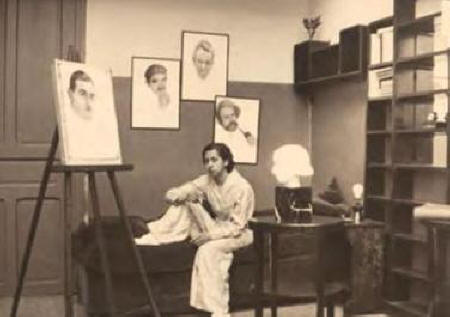Queer Places:
Cementerio Central
Bogotá, Ciudad de Bogotá, Distrito Capital, Colombia
 Hena Rodríguez (20 May 1915 – 17 April 1997)[1] was one of the first Colombian women to become a sculptor. She taught at the National University of Colombia and University of Los Andes, before becoming the founding dean of the Faculty of Arts at the latter institution. Her sculpture Cabeza de Negra is in the collection of the Colombian National Museum and a painting Espalda is part of the Art Collection of the Bank of the Republic. Rodríguez lived openly as a lesbian[1][10] and often wore men's clothing and short hair. She was a friend of many artists and ceramicists, such as
Elvira Martínez,
Elisa Mujica and
Carolina Cárdenas.[5][11]
Hena Rodríguez (20 May 1915 – 17 April 1997)[1] was one of the first Colombian women to become a sculptor. She taught at the National University of Colombia and University of Los Andes, before becoming the founding dean of the Faculty of Arts at the latter institution. Her sculpture Cabeza de Negra is in the collection of the Colombian National Museum and a painting Espalda is part of the Art Collection of the Bank of the Republic. Rodríguez lived openly as a lesbian[1][10] and often wore men's clothing and short hair. She was a friend of many artists and ceramicists, such as
Elvira Martínez,
Elisa Mujica and
Carolina Cárdenas.[5][11]
Hena Rodríguez Parra was born on 20 May 1915 in Bogotá, Colombia.[2] She became interested in art at a very young age, as her family lived across the street from the Spanish sculptor Ramón Barba Guichard. Barba began teaching her.[3]
Between 1930 and 1935, Rodríguez studied at the School of Fine Arts of Bogotá (Spanish: Escuela de Bellas Artes de Bogotá) with Barba, Francisco Antonio Cano, Coriolano Leudo, Eugenio Peña, Roberto Pizano, and others. While in school, in 1930, she joined Dario Achury Valenzuela, Rafael Azula Barrera, Tulio González, Darío Samper and Juan P. Varela in founding the Bachué Movement, an avant-garde art affiliation which saw art of the Americas as one with its own indigenous roots and influences.[2][4] She was the only woman in the group,[4] that created the first modernist art movement in the country.[5]
In the 1930s, Rodríguez collaborated with other artists on the façade of the Cathedral of Bogotá.[6] In 1935, she enrolled at the Real Academia de Bellas Artes de San Fernando in Madrid and during her years in Europe took study trips to Germany, Italy, and Morocco, as well as London and Paris. Earning a government scholarship in 1936, she participated in the Exposition Internationale des Arts et Techniques dans la Vie Moderne in 1937, winning a gold medal for her exhibit in the Uruguayan Pavilion and an honorable mention at the Salon d'Automne that same year.[2][7]
Returning to Colombia in 1938, she began working as an art teacher at the School of Fine Arts of the National University of Colombia.[5] She completed a bust of Julio Flórez, which was installed on Calle 26. The following year, her bust of Antonio José Restrepo was installed at Titiribí. In 1940 she exhibited three pieces in the First Annual Salon of Colombian Artists and in 1942 received an honorable mention in New York City at the Macy's Latin American Fair.[2]
In 1944 Rodríguez joined the faculty as a professor at the School of Fine Arts at the University of Los Andes. That same year, she held a solo exhibition at Bogotá's Hotel Granada. In 1945, she won the bronze medal for her wood carving Cabeza de Negra (Black woman's head) at the 4th Salon of Colombian Artists.[2] The sculpture, owned by the Colombian National Museum, depicts a strong, proud negress, with sensual, fleshy lips.[5] She founded the Museum of Impressions and Reproductions (Spanish: Museo de Impresiones y Reproducciones) in the Teatro de Cristóbal Colón that same year. The museum featured portraits and sculptures of great artists and her own works housed here included Manos de Nicanor Zabaleta (Hands of Nicanor Zabaleta), Manos de (niño) Roberto Benzi (Hands of the child Roberto Benzi, and Manos de Andrés Segovia (Hands of Andrés Segovia), among others.[2]
In 1954, she was one of the founders of the Women's University and became the director of the art section. The director of the University itself was the pianist Elvira Restrepo de Durana.[8] The idea of the Arts Workshops were to give upper-class women instruction in the fine arts to free them from the strict social customs which required that must be chaperoned, were barred from university, and incapable of intellectual conversation. The courses, first held in the laundry of a former women's prison and a women's mental asylum, followed a curricula of three years of fine arts academic work with an additional two years of independent study and practical application.[4] Rodríguez was the first dean of the Faculty of Arts when the program was incorporated into the University of Los Andes.[6] In 1968, Rodríguez was forced to retire and was awarded the university's highest honor, the Chivo de Oro.[4]
Rodríguez primarily worked as a sculptor, in wood, marble and stone;[6] however, she also painted. One such painting, Espalda (Back, 1945) is in the collection of the Art Collection of the Bank of the Republic. The painting features the back of a female nude figure, which utilizes a dramatic lighting effect to highlight the contours of her shape and pull it into the foreground. The pale pinks, reds and greens used in the oil painting, red drape and short hair, emphasize the appreciation of the female form.[9] Her sculptures, many of the female form, moved away from the mythical, romanticized Art Nouveau portrayals of femininity and motherhood and instead tried to capture the essence of women's power, often depicting indigenous, negro women or peasant women.[5]
After her forced retirement, Rodríguez and her work were long forgotten. For much of the twentieth century, there was a myth that there were no women artists in Colombia and the few that were able to work at their craft were rarely purchased by museums or their works shown. Scattered acquisitions by the Bank of the Republic for its art collection were known in the 1950s to 1970s, but regular acquisitions did not begin until the 1980s. The National Museum lagged far behind other museums.[5] In 1982, she was among the party which accompanied Gabriel García Márquez, by government request, to Stockholm to accept his Nobel Prize for literature.[6]
Rodríguez died 17 April 1997 in Bogotá[1] and was interred in the Central Cemetery of Bogotá.[6] Since her death, Rodríguez's significance and that of the Bachué Movement has been re-evaluated and is recognized as a significant contribution to the development of modern art in Colombia.[12]
My published books:


BACK TO HOME PAGE

 Hena Rodríguez (20 May 1915 – 17 April 1997)[1] was one of the first Colombian women to become a sculptor. She taught at the National University of Colombia and University of Los Andes, before becoming the founding dean of the Faculty of Arts at the latter institution. Her sculpture Cabeza de Negra is in the collection of the Colombian National Museum and a painting Espalda is part of the Art Collection of the Bank of the Republic. Rodríguez lived openly as a lesbian[1][10] and often wore men's clothing and short hair. She was a friend of many artists and ceramicists, such as
Elvira Martínez,
Elisa Mujica and
Carolina Cárdenas.[5][11]
Hena Rodríguez (20 May 1915 – 17 April 1997)[1] was one of the first Colombian women to become a sculptor. She taught at the National University of Colombia and University of Los Andes, before becoming the founding dean of the Faculty of Arts at the latter institution. Her sculpture Cabeza de Negra is in the collection of the Colombian National Museum and a painting Espalda is part of the Art Collection of the Bank of the Republic. Rodríguez lived openly as a lesbian[1][10] and often wore men's clothing and short hair. She was a friend of many artists and ceramicists, such as
Elvira Martínez,
Elisa Mujica and
Carolina Cárdenas.[5][11]

